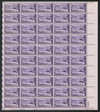
1953 3¢ Trucking Industry
# 1025 - 1953 3¢ Trucking Industry
$0.35 - $18.50
U.S. #1025
3¢ Trucking Industry
3¢ Trucking Industry
Issue Date: October 27, 1953
City: Los Angeles, CA
Quantity: 123,709,600
Printed by: Bureau of Engraving and Printing
Printing Method: Rotary Press
Perforations: 11 x 10½
Color: Violet
City: Los Angeles, CA
Quantity: 123,709,600
Printed by: Bureau of Engraving and Printing
Printing Method: Rotary Press
Perforations: 11 x 10½
Color: Violet
U.S. #1025 commemorates the first years of the trucking industry. The stamp pictures a 1950s-era truck with farm and city scenes in the background, representing the way trucking delivers goods between both settings.
Early Days of the Trucking Industry
Prior to 1900, most freight was carried by trains, which could move large amounts of products, but only to urban areas where the items were then transported by horse-drawn wagons. The earliest trucks were often more popular for their advertising space than carrying freight. A lack of paved roads in rural areas, small engines and limited capacities made trucks less desirable.
By 1910, the gasoline-powered internal combustion engine, improved transmissions, introduction of gear drives, and tractor and semi-trailers helped to greatly improve the popularity of trucking across the country. Within four years, almost 100,000 trucks were hitting the roads of America. The trucking industry still had its problems, as road conditions were still poor and the maximum speed limit in many areas was only 15 miles per hour.
During World War I, railroads became overloaded helping the war effort, and the need for an improved trucking industry became apparent. It was at this time that Roy Chapin experimented with the first long-distance truck shipments and inflated tires able to carry heavier loads, allowing trucks to drive at higher speeds. By 1920, more than one million trucks traveled America’s roads.
The trucking industry continued to flourish with the introduction of the diesel engine, improved roads, standardized truck and trailer sizes, fifth wheel coupling systems, and power brakes and steering.
U.S. #1025
3¢ Trucking Industry
3¢ Trucking Industry
Issue Date: October 27, 1953
City: Los Angeles, CA
Quantity: 123,709,600
Printed by: Bureau of Engraving and Printing
Printing Method: Rotary Press
Perforations: 11 x 10½
Color: Violet
City: Los Angeles, CA
Quantity: 123,709,600
Printed by: Bureau of Engraving and Printing
Printing Method: Rotary Press
Perforations: 11 x 10½
Color: Violet
U.S. #1025 commemorates the first years of the trucking industry. The stamp pictures a 1950s-era truck with farm and city scenes in the background, representing the way trucking delivers goods between both settings.
Early Days of the Trucking Industry
Prior to 1900, most freight was carried by trains, which could move large amounts of products, but only to urban areas where the items were then transported by horse-drawn wagons. The earliest trucks were often more popular for their advertising space than carrying freight. A lack of paved roads in rural areas, small engines and limited capacities made trucks less desirable.
By 1910, the gasoline-powered internal combustion engine, improved transmissions, introduction of gear drives, and tractor and semi-trailers helped to greatly improve the popularity of trucking across the country. Within four years, almost 100,000 trucks were hitting the roads of America. The trucking industry still had its problems, as road conditions were still poor and the maximum speed limit in many areas was only 15 miles per hour.
During World War I, railroads became overloaded helping the war effort, and the need for an improved trucking industry became apparent. It was at this time that Roy Chapin experimented with the first long-distance truck shipments and inflated tires able to carry heavier loads, allowing trucks to drive at higher speeds. By 1920, more than one million trucks traveled America’s roads.
The trucking industry continued to flourish with the introduction of the diesel engine, improved roads, standardized truck and trailer sizes, fifth wheel coupling systems, and power brakes and steering.











